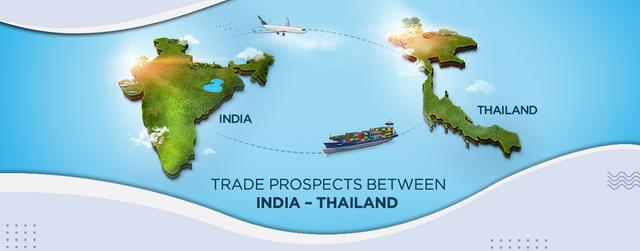
Cogoport Enables Movement of 11 Envirotainer Containers from India to Italy
Cogoport’s collective logistics and technical expertise came in handy as our operations and technical teams went the extra mile and designed...
As key players in the South Asia and Southeast Asia geographies, India and Thailand have deep rooted historical, cultural and trade ties. Leveraging its links with Thailand, India can find better access to trade with the $2.3 trillion ASEAN Economic Community market. Read on to know more about the trade potential between the two countries and beyond.

Located in the extended neighbourhood with a maritime boundary in the Andaman Sea, India and Thailand are deeply connected historically, with ancient social and cultural interactions and people to people contacts. Besides this, Thailand presents major trade potential, including chipping in with demand around the Chinese lunar New Year, when trade subsides with China.
With a 60 percent rise in pre-pandemic trade growth between India and Thailand by 2019, in three years from 2016, India can further boost trade with Thailand. According to the Ministry of External Affairs (MEA), bilateral trade touched $12.46 billion in 2018. Thailand’s exports to India amounted to $7.6 billion and imports from India were $4.8 billion.
Bilateral trade improved from $7.72 billion in 2016 and $10.39 billion in 2017. It marginally slid off to $12.12 billion in 2019 and further crashed to $9.76 billion in 2020 and $4.84 billion till April 2021 due to the Coronaviruspandemic.
According to the ASEAN Economic Community’s (AEC) blueprint, which comprises Thailand as a member and is estimated to be a market of $2.3 trillion, powered by a consumer base of 600 million population, the ultimate aim is to achieve a common market with greater integration among members.
The blueprint aims to usher in seamless movement of goods, tariff rationalization and an open and predictable investment climate in ASEAN countries. AEC provides India with an opportunity to tap the $2.3 trillion market through Thailand, which was predicted by economists to become one of the largest economic blocs by 2030.
Aimed at better access and cutting travel time between India and Thailand to a week from a fortnight under a new agreement, a new maritime route was also planned to be promoted between the two countries, including a transshipment hub.
Indian ports lose $220 million of potential revenues due to cargo transshipments through international ports. This subjects Indian exports to cost vulnerabilities, congestion, inefficiencies and affects trade competitiveness. It costs up to $100 more for each 20-foot container (TEU) to be handled at foreign transshipment hubs. Currently, the majority of India’s transshipments occur at Colombo, Singapore, and Port Klang.
These reasons have made a compelling case for a transshipment hub at an ideal location in southern India. The Indian government has initiated steps to build a transshipment terminal at the Great Nicobar Island in Andaman and Nicobar islands and intends to set up more such terminals in the future. Great Nicobar can emerge as an alternative transshipment facility in the region, which can enable it to tap into international shipping traffic for good dividends.
As part of the Thai government’s southern economic corridor (SEC) infrastructure development plan, the Southeast Asian nation drew plans worth $3.5 billion to be spent in a space of four years, half of which will be used to develop the Ranong deep seaport and airports in four provinces.
SEC envisages to become a gateway to South Asia and this vision calls the Port Authority of Thailand to enhance Ranong Port as the logistics gateway between India and Thailand, raising its capacity by more than six times to reach 5 lakh 20-foot containers (TEU) per year by 2022.
Meanwhile, China United Lines (CU Lines) is launching a new route with Global Feeder Shipping and Emirates Shipping Line, Vietnam-Thailand-Middle East ExpressVGX, in January 2022, aimed at expanding its intra-Asia network and providing a new direct route to Southeast Asia and Middle East shippers.
Equipped with five vessels of up to 2,100 TEU capacity, the new service will feature faster delivery in the market with streamlined port calling. Its port rotation schedule will be in the order of Ho Chi Minh, Laem Chabang, Port Klang W, Sohar, Jebel Ali, Nhava Sheva, Port Klang and Ho Chi Minh.
Thailand is also a part of the Bay of Bengal Initiative for multi-sectoral technical and economic cooperation (BIMSTEC) while the former and India were seen as good beneficiaries of the protracted trade war between the US and China in recent times. Both the countries also cooperate through the platforms of EAS, MGC, ACD, IORA and ACMECS.
India - ASEAN Agreement on Trade in Goods was implemented in January 2010 while the India-ASEAN FTA in Services and Investment was inked in September 2014 and came into force in July 2015.
Despite these impressive statistics and potential, the Indian Cellular and Electronics Association (ICEA) pointed out that India’s policy of high import tariffs on electronic components aimed at protecting the domestic industry has proved to be counterproductive to its plans of production linked incentive scheme.
According to the ICEA, this policy has made the Indian electronic manufacturing industry uncompetitive, compared to countries such as China, Thailand, Mexico and Vietnam, which gained majorly in the past two decades.
ICEA noted that higher tariffs orient the approach of investors and domestic producers away from global markets and towards the domestic market. One of the major requests from the industry to the Indian government in the forthcoming budget for 2022–23 is to slash import tariffs to make India competitive in the global markets.
Harsha Vardhana Singh, former deputy director general at the World Trade Organisation highlighted that for India to integrate into the global supplychains, its tariffs on inputs should not be higher than its competitors.